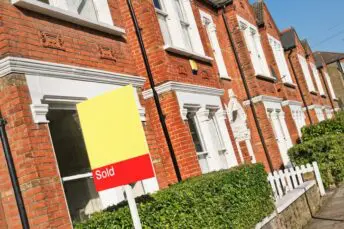House Price Watch Jan 2024
There are early signs of a pick up in market activity with the first increase in buyer demand and highest increase in new sales instructions in more than a year. There have been encouraging signs for buyers with mortgage rates coming down, although affordability pressures remain with average monthly mortgage repayments still above the long run average and house prices still high relative to earnings. While house prices increased this month, with good availability of homes for sale and ongoing stretched affordability, houses prices are expected to remain stable in the months ahead.
What’s happening nationally
House prices are up on average +0.7% over the past month and +0.3% over the past year.
Land Registry reporting December figures shows the smallest monthly rise in house prices (+0.1%) and Halifax (+1.3%) and Rightmove (+1.3%), the biggest. Halifax also reports a rise in house price growth over the past year (+2.5%), while the other indices report a fall in annual house price growth.
Indices based on:
Land Registry – registered property transactions in December.
Nationwide & Halifax – mortgage valuations in January.
Rightmove – asking prices posted on Rightmove in January.
*Rightmove is not included in the index average as the basis for its index is different (asking price vs agreed sale price)
| Index reports: | Monthly change | Annual change |
|---|---|---|
| Land registry | +0.1% | -1.4% |
| Nationwide | +0.7% | -0.2% |
| Halifax | +1.3% | +2.5% |
| Rightmove | +1.3% | -0.7% |
| Average change | +0.7% | +0.3% |
House prices in your area
House price fluctuations over the past month show a mixed picture across the UK with Land Registry reporting house prices up this month in the West Midlands (+2.6%), the North West (+2.5%), the East Midlands (+1.6%), Wales (+0.9%) and Yorkshire (+0.1%) and steady or down in other areas of England, down in Scotland (-0.9%) and down in Northern Ireland (-0.9%).
House prices are down over the past year in Wales (-2.5%) and most areas of England, with the exception of the North West (+1.2%) and the West Midlands (+0.3%). House price growth inceased over the past year in Scotland (+3.3%) and Northern Ireland (+1.4%).
Average house prices remain highest in London (£508K) and lowest in the North East (£158K).
All types of properties have experienced a fall in house prices over the last year: Terraced (-2.5%), Flats/ maisonettes (-2.3%), Semi-detached (-0.2%) and Detached (-0.8%) according to December Land Registry data.
| UK Region | Average price £ | Monthly change | Annual change |
|---|---|---|---|
| England | |||
| Nothern Ireland | |||
| Scotland | |||
| Wales | |||
| North West | |||
| Yorkshire and The Humber | |||
| North East | |||
| West Midlands | |||
| East Midlands | |||
| South West | |||
| East of England | |||
| South East | |||
| London |
| UK City | Average price | Annual change |
|---|---|---|
Market Monitor
There were 80K transactions in December, down slightly from November, 18% lower than December 2022.
Annual transactions fall 19% year on year. In 2023, there were 1 million transactions and in 2022 1.265 million (down 19%).
Demand has started to pick up with new buyer enquiries up and new sales instructions also up. Average stock per agent fell in December.
Time to sell increased to 71 days in December up from 66 days in November. Time to sell is up significantly from last December (52 days last December).
How busy is the market?
- Not busy
- Normal
- Very busy
- Transactions down slightly in December. 2023 transactions of 1 million down 19% from 2022, 1.265 million
- Total transactions in December 80K
- -0.8% from last month
- -18% from December last year
Homes for sale vs homebuyers
- Good availability of homes
- Normal
- Shortage of homes
- Buyer enquiries up(+7% RICS); highest level since Feb 2022
- Seller enquiries up (+11% RICS); highest level since Mar 2021
- Average stock per agent (Dec figures) 49; down from 52 in Nov (incl under offer/ Sold STC Rightmove)
Average speed of sale
- Fast
- Normal
- Slow
- 71 days to find a buyer in December, up from 66 days in November (up from 52 days last December, Rightmove)
What the experts say
Rightmove - agent's view

“After a stop-start market in 2023, the initial signs suggest a smoother year for movers in 2024. More new sellers are now entering the market, and with more confident pricing. The number of new properties for sale is 15% higher than in the same period last year. Buyer demand in the first week of 2024 is 5% higher than in the same period last year. However, competitive pricing from sellers is still vital, with the number of new properties coming to market outpacing the rise in demand. Accurate and realistic pricing for their local area is the recipe for success for sellers looking to get moving in 2024, and it’s been proven that over-optimistic pricing makes a move much less likely.”
Nationwide

“While a rapid rebound in activity or house prices in 2024 appears unlikely, the outlook is a little more positive. How mortgage rates evolve will be crucial, as affordability pressures were the key factor holding back activity in 2023. At the end of 2023, a borrower earning the average UK income and buying a typical first-time buyer property with a 20% deposit had a monthly mortgage payment equivalent to 38% of take-home pay – well above the long run average of 30%. If average mortgage rates were to trend down to 4%, this would ease the mortgage payments burden to 34% of take-home pay (assuming house prices and earnings are unchanged). However, other things being equal, mortgage rates of 3% would be needed to bring this measure of affordability back towards its long run average. Raising a deposit also remains a major challenge with a 20% deposit on a typical first-time buyer home equating to c.105% of average annual gross income. House prices are still very high relative to earnings, with the house price to earnings ratio standing at 5.2 at the end of 2023, well above the long run average of 3.9.”
Halifax

“The recent reduction of mortgage rates from lenders as competition picks up, alongside fading inflationary pressures and a still-resilient labour market has contributed to increased confidence among buyers and sellers. This has resulted in a positive start to 2024’s housing market. However, interest rates remain elevated compared to the historic lows seen in recent years. For those looking to buy a first home, the average deposit raised is now £53,414, around 19% of the purchase price. Looking ahead, affordability challenges are likely to remain and further modest falls should not be ruled out, against a backdrop of broader uncertainty in the economic environment.”
Zoopla (Hometrack)

“There has been a strong seasonal rebound in sales activity in the first weeks of January on the back of pent up demand and sub -5% mortgage rates. It’s a positive start to the year but this is a rebound off a low base. Buyer demand is 12% higher than a year ago but remains 13% below the five year average. And, the number of homes for sale is more than 20% higher than a year ago. Sub-5% mortgage rates are encouraging but buyers remain price sensitive and focused on value for money. It remains a buyers’ market with a fifth of sellers having to accept more than 10% below the asking price to secure a sale. There is upside for sales volumes but prices still need to adjust to allow for reduced buying power.”
RICS

“The January 2024 RICS UK Residential Survey results show another slight improvement across all sales market activity indicators. Moreover, sentiment regarding the outlook for sales volumes over the coming twelve months has turned increasingly positive, supported by expectation that interest rates will ease back to a certain degree as the year progresses.”




